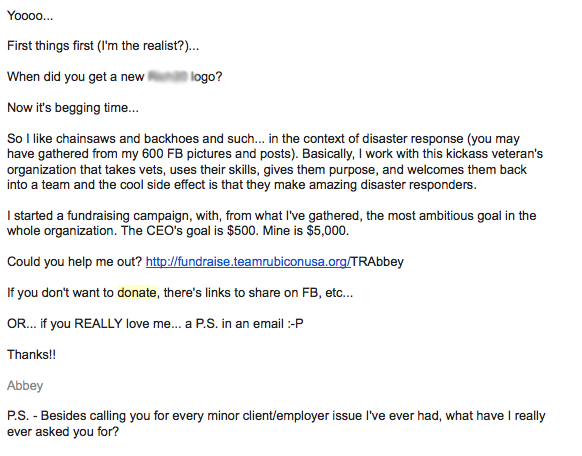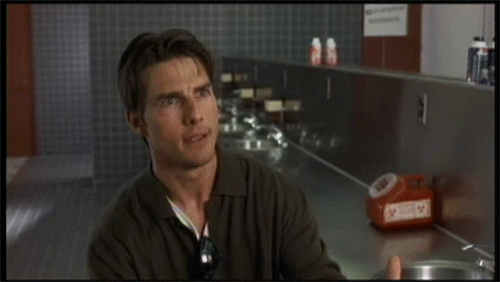Life likes to throw a whole bunch of crazy all at once, doesn’t it?
I’m currently in the middle of writing an epically long post about my last 4 weeks which included zero copywriting but a big smack in the face on the personal front (there’s some serious lessons about what to say in the most awkward of situations coming your way shortly).
Yesterday, a situation came up I wanted to share first. So I’m stepping back from megapost to show you how to get support for your pet projects and passions — even from strangers.
A few days ago, while I was still decompressing, I got an email asking me to participate in Team Rubicon’s response following in the wake of the earthquake in Nepal. They’re deploying some amazing technology that will help multiple organizations in their response for literally years to come.
Because I’ve taken the last month off of work, another 21 days abroad with no internet wasn’t going to be in the cards this time.
So instead of making headlines with some of my TR brothers, I’m stepping back and supporting with my dollars.
What does this have to do with copy?
Pretty much everything.
Last time I launched a campaign for TR I was the top regional fundraiser — because of copy.
So let’s break it down
Here’s a snapshot from my fundraising page from back in July.
Let’s take a look at what I’m doing here.
Section 1: Answer the question — why does Abbey want my money?
Team Rubicon provides some generic copy to use on your fundraising page, but most people that will land here are landing here because of me, not because of Team Rubicon. So I opened with what any of this had to do with me (and a few cool images for credibility).
Thanks for stopping by! If you’re here, you probably know how passionate I am about Team Rubicon.
Here’s just a few pics of me working TR ops:
Section 2: Why do I care about this at all?
The key to this section is hitting hard emotionally — and quickly. Notice the specificity in these examples. I could say things like “muck out operations” or “retrieval of personal effects” — these are the words we use internally, but instead I paint the picture of what these situations actually look like.
But the thing is, this isn’t about me. It’s about the work that TR can do with your donation:
-
Help a family whose home was destroyed find their valuables – before the looters do
-
Muck out a house damaged by flood, saving a family weeks of heartache and thousands of dollars
-
Provide medical care after a disaster to an injured child who’s lost everything
Section 3: Answer objections — is this secure? How long will it take?
This is a quick sentence that heads off the technical objections before they arise.
Help me support Team Rubicon by making a donation. The process is fast, easy, and secure. I truly appreciate any support you can provide.
Section 4: Guide their donations
If you’ve ever received a donation card in the mail you’ll notice that they suggest amounts. For example, it might say: $25, $50, $100, or other.
The principle at play here is that nobody wants to give less than the suggested amount. (Stayclassy.org, a partner of Team Rubicon explains more here.)
I do a few things here. First off, I’m again specific about what the donation does. “If I send you $50, what will you do with it?” It’s crystal clear here.
Also, you’ll notice that the amounts aren’t really “even.” I start with $25 which is a nice round number because this is the lowest amount. It’s safe and easy. But, many people hate picking the lowest number and will jump up to the next level just because.
You’ll notice that jump is to $60 and not $50. The reason is,someone may be planning to donate $50, but upon seeing this list may want to “level up” and kick in an extra $10.
Here’s what your donation can do:
$25 supplies a group of spontaneous volunteers (like a high school football team out for a Saturday of service) with gloves and glasses – meaning we can clear debris/muck out a house – saving a distressed homeowner weeks of work/thousands of dollars.
$60 outfits a TR volunteer with personal protective equipment (PPE)– meaning they’re able to kick ass in the field and perform any task asked of them – safely.
$120 trains a volunteer in incident management, so once they’re out in the field, they can provide aid like a boss – making us one of the most efficient and effective disaster organizations
$300 Drops a tools, tactics, and techniques knowledge bomb on a volunteer. Example: Me. I’m now trained in heavy equipment, chainsaw ops, and first aid, so we’re ready for whatever mother nature throws our way.
$600 deploys and outfits an entire strike team for a one week operation. Chainsawing trees? Debris removal? These guys do it all.
$1200 builds a Forward Operating Base (FOB). From the FOB, we’re able to direct our strike teams and organize gear and supplies, key for a large-scale response.
Section 5: Capture the people that really can’t/won’t part with their money
Some people just won’t donate — for a variety of reasons — and that’s ok! If they’ve made it this far on the page, they are interested in what I have to say, so I help them help me.
If you can’t make a donation at this point, help me reach my goal by sharing this page on Facebook and Twitter!
Or, even better, send an e-mail to friends you think might be interested in contributing and include a link to my page!
Section 6: Give them an identity
This is the most “copy” tip of all. It comes from the theory of The Looking-Glass-Self. The short version is, we get our perceptions of ourselves by what we see others reflect. When a child is told repeatedly they are funny, they tend to tell more jokes. If you tell someone they are a hard worker, they tend to work harder.
So here, saying my friends are generous (which is also true), may prompt someone to be even more so.
Thanks so much… seriously, I have the most generous peeps around.
Two more critical lessons about donations
- Donations make people feel good. Asking for money isn’t fun. In fact, I hate it. But remember, people are SEEKING ways to help. I’ve seen it hundreds of times in the wake of disaster. People ask, “What can I do? How can I help?” Have you seen images on TV and just wanted to do something? What if, in that moment, someone handed you a way to make a real difference. You would be grateful, not annoyed.
- None of this works without getting personal. Yes, the copy helped tremendously, but what really made the difference on this page was HOW people got there. I reached out (personally — no mass emails) and asked people to donate. And it wasn’t sleezy and corporate. It was me. Here’s the exact email I sent (I sent dozens of these):

Notice how I opened with a personal question so he knew I wasn’t just spamming everyone on my list. Your friends like you, so when you ask them directly, they want to help.
Ok wow. I just went back up to the top of this post and deleted “quickly” out of the third paragraph. This turned into a pretty mega post on it’s own.
If you’ve made it this far, I only have one thing to ask. I’m at it again so you can hope over to my donation page here. Check out the updated copy and see if you can find improvements, changes, or other principles at work. Comment below with any questions or insights and I’ll reply.
And, while you’re there, feel free to throw a couple bucks toward a great cause. 😉
-Abbey
P.S. Stay tuned, I’m really excited about my next post. Working title is “What to say in those situations where you have no idea what to say”



More!